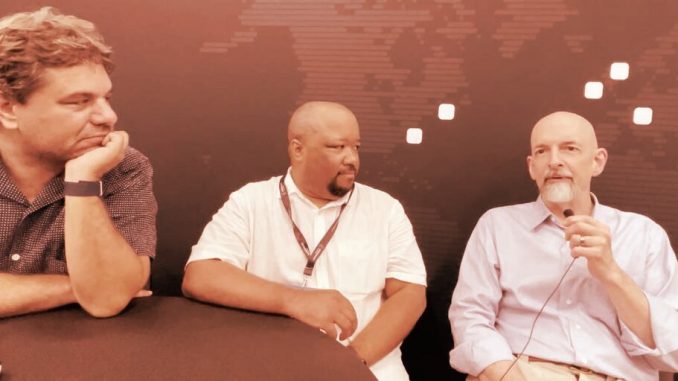
Nearly 30 years before Facebook became Meta, there was “the metaverse.” The author Neal Stephenson coined the term in his cyberpunk novel Snow Crash in 1992 to describe an online, VR-ish world where the inhabitants of humankind could interact and escape the dystopian unpleasantness of meatspace.
Though Stephenson has long been fascinated by cryptography and digital money, as evidenced by his novel Cryptonomicon, he has admitted to being slow to embrace the actual crypto movement. That changed this week with his involvement in the launch of Lamina1, announced at the Consensus conference in Austin, Texas.
The project describes itself as a “free metaverse” aimed at “helping get artists and other value creators paid properly for their work, helping the environment (Lamina1 will be provably carbon negative), and seeing a truly Open Metaverse get built instead of seeing the Metaverse vision co-opted by monopolies.”
In an interview with Decrypt, Stephenson and Lamina1 co-founder Peter Vessenes, a crypto pioneer and co-founder of the Bitcoin Foundation, elaborated a bit on the project.
“Lamina1 is a purpose-built blockchain for building the open metaverse,” Vessenes explained. “We’re going to have all the facilities of a full layer one [blockchain] to help support and encourage the creators who want to build with us. That is my and Neal’s strategy—align everything around getting the best thing built and getting everybody all the tools they need to build what they want.”
Stephenson said that when envisioning the metaverse in Snow Crash, he did not foresee Web3, but says blockchain technology is necessary to at last make the metaverse happen.
“I think it’s implicit in Snow Crash that none of what you’re seeing there could really exist as described without some kind of decentralized payment system,” Stephenson says. “There’s no, like, one big bank that is sitting there processing all of those zillions of transactions.”
Stephenson said that by the time his next book, Diamond Age, was released in 1995, he had started to interact with people who understood what he calls the “nascent cryptocurrency and cryptography industries.”
It was in writing that book that he really began to understand the idea of the metaverse in a more specific way, including as a global media network: “It’s a key plot point in the storyline that anonymous payments are happening on this network. Because basically, without that detail, the entire storyline would implode.”
For Vessenes, Web3 and Lamina1 are a way to address fundamental inequities in the current Web2 ecosystem.
“We make content, we make stuff that’s valuable and then we give it to the large West Coast tech monopolies for free, in exchange for likes [on social media],” Vessenes said. “Not that people shouldn’t have the right to build free things and give them away and do what they want. But the hope of blockchain, of a decentralized setup, is that the value flows, much more fairly to everybody. That’s kind of our utopian dream.”
Vessenes said the launch team is still in the very early stages of development, raising funds, and hiring. It just closed a friends-and-family investment round, and they’re aiming for a beta rollout in the fall. He invited people interested in participating to join the project’s Discord at discord.gg/lamina1.
“There’s an immense amount of work to do,” Vessenes said. “If you want to come to actually work, we’ve got stuff for people to do. And that’s where you’ll be able to get access to what’s next.”
Want to be a crypto expert? Get the best of Decrypt straight to your inbox.
Get the biggest crypto news stories + weekly roundups and more!





Be the first to comment